Geotechnical investigation of pavement failure; causes and inherent solutions for sustainable highway construction in Sub-Saharan Africa
DOI:
https://doi.org/10.17794/rgn.2020.4.9Keywords:
Pavement failure, Geotechnical parameters, Road foundation, Clay activity, Ibadan-Iwo-Osogbo highwayAbstract
Engineering geological investigation of some unstable and stable sections of the Ibadan-Iwo-Osogbo highway was undertaken to unravel the intrinsic reasons responsible for continuous pavement failure along this road. Eighty disturbed and forty undisturbed soil samples were collected at different depths from twenty test pits of six selected failed sections (FS) and two stable sections (SS). Road construction analysis was done on these soil samples using standard methods. Liquid limit (22 - 64 % and 32 - 40 %), plasticity index (13 - 41 % and 12 - 18 %) and percentage fines (47 - 59 % and 32 - 41 %) indicated fair to poor and fair to good subgrade materials of FS and SS respectively. Medium to high plasticity and high clay content of soils of FS are indicative that the soils possess medium to high swelling potential. The activity of clay in soils of FS was approximately 0.3 – 1.2 and classified as inactive to normal clay. High linear shrinkage (>10 %), low compacted density and predominance of fines in soils of FS caused the instability. Exposure to excessive moisture led to strength reduction of the soils. Triaxial compression showed cohesion (72.6 - 127.0 kN/m2) and internal friction (12.7° -33.3°) indicating moderate to good shearing strength of the soils. A coefficient of compressibility of 0.1 – 0.5 kN/m2 indicated incompetency of the soils for road construction and the coefficient of consolidation was 0.01 – 0.30 m2/year. The subsoil of the FS is impervious with a relatively low coefficient of permeability, indicative high saturation in the region. Thus, the pavement failure was caused by water absorbing clayey soil, poor geotechnical parameters of the soils and a poor drainage network.
Downloads
Published
How to Cite
Issue
Section
License
Copyright (c) 2020 authors and journal

This work is licensed under a Creative Commons Attribution 4.0 International License.
Creative Commons-BY
Authors who publish with this journal agree to the following terms:
In agreeing this form, you certify that:
- You read the ethical codex of the RGN zbornik available at journal web.
- You submitted work is your original work, and has not previously been published and does not include any form of plagiarism.
- You own copyright in the submitted work, and are therefore permitted to assign the licence to publish to RGN zbornik.
- Your submitted work contains no violation of any existing copyright or other third party right or any material of an obscene, libellous or otherwise unlawful nature.
- You have obtained permission for and acknowledged the source of any illustrations, diagrams or other material included in the work of which you are not the copyright owner.
- You have taken due care to ensure the accuracy of the work, and that, to the best of your knowledge, there are no false statements made within it.
- All co-authors of this submitted work are aware of, and in agreement with, the terms of this licence and that the submitted manuscript has been approved by these authors.
Publication licence
You retain copyright in your submitted work, according to journal license policy (CC-BY). By signing this form you agree that RGN zbornik may publish it under the publication licence. In summary the licence allows the following:
Anyone is free:
- To copy, distribute, display, and perform the work.
- To make derivative works.
Under the following conditions:
- The original author must always be given credit.
- The work may not be used for commercial purposes.
- If the work is altered, transformed, or built upon, the resulting work may only be distributed under a licence identical to this one.
Exceptions to the licence
In addition to publishing the work printed under the above licence, RGN zbornik will also enable the work to be visible online.
The journal editorial can change the licence rules anytime but it cannot retroactively restrict author(s) rights.


